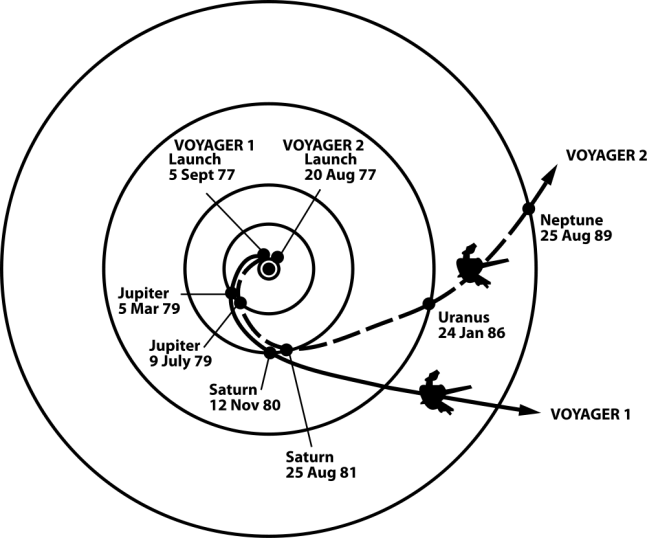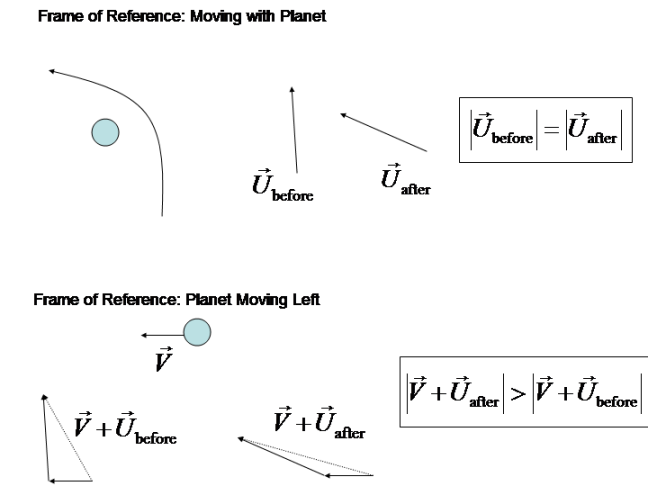It’s been a long time since I wrote about my research, as I once said (rather haughtily) everyone should do, so I’ll get back into the saddle.
Like all good science, this work started as a rather rambling lunch-time conversation about how humans should physically explore the Galaxy. We took our inspiration from humankind’s exploration of the Solar System:

The Voyager spacecraft were launched with the primary function of exploring the outer Solar System planets and their environment, but have also travelled to far greater distances from the Sun. Voyager 1 remains a scientifically viable instrument, despite being over 11 billion miles from its launch site – signals from the spacecraft take over a day to arrive at Earth despite travelling at the speed of light!
How the Voyagers managed to accelerate themselves sufficiently to travel so far from the deep gravitational well of the Solar System is a neat example of the conservation of energy. The planets possess an enormous amount of energy stored in their orbital motion, and this energy source can be tapped using a gravitational slingshot maneouvre. The probe slings around the planet, using the planet’s gravitational field to change its trajectory and fling it in a different direction.

An observer standing on the planet’s surface will measure the speed of the probe to be the same before and after the slingshot (see diagram), but the planet itself is moving. An observer floating at rest will measure the speed of the probe as it leaves to be different from the speed it possessed when it arrived at the planet. If the planet and the probe are moving towards each other during the slingshot, then the probe’s speed will be boosted. Alternatively, if the planet is moving away from the probe as the probe begins the maneouvre, then the probe’s speed will be decreased (this can be used to capture satellites in orbit).
The probe and the planet are exchanging momentum during the interaction. If the probe speed is boosted, the probe is depleting the planet of orbital energy! Luckily, the amount of energy it extracts is minimal in comparison to the total available energy, so Jupiter and Saturn aren’t going to be crashing into the inner Solar System any time soon.
This brings us back to our lunch-time conversation. Gravitational slingshots need a massive body that orbits around some central object. This is obviously true for the Solar System, but this is also true for the Galaxy. The Galaxy has a centre, occupied by a supermassive black hole. While the Sun is not gravitationally bound to it, it does orbit around it at approximately 200 km/s. In other words, there’s plenty of orbital energy out there for interstellar probes to use!
We calculated that if a probe carries out a series of slingshots as it tours the Galaxy, the probe can be accelerated to approximately 1% of the speed of light without shipping enormous amounts of fuel (bear in mind Voyager 1 is travelling at 0.003% of lightspeed). This got us thinking about Fermi’s Paradox.
Fermi’s Paradox simply wonders, given the large length of time that the Galaxy has existed, and the relatively small length of time it would take to travel from end to end at a small fraction of lightspeed, why aliens haven’t shown their own presence. This Paradox gets stronger if we consider aliens sending probes that are self-replicating, making copies using material they find along the way. Surely, this rapid spread of probes across the stars, growing their population exponentially like bacteria, would be so pervasive that we would have spotted one by now?
In the past, when SETI scientists simulate this type of exploration, simple trajectories for the probes are used, and they all travel at a relatively high fixed speed. We wanted to see what adding gravitational slingshots to these simulations would do. Our hunch was that this would make Fermi’s Paradox even stronger. The result – it does. Adding gravitational slingshots to the probe trajectory allows even spacecraft as slow as Voyager to explore a patch of the Milky Way around 100 times faster at vanishing energy cost!
So, even if ET is somewhat frugal with its resources – one reason often proposed as a solution to the Fermi Paradox – gravitational slingshots show that’s no reason not to explore the Milky Way…